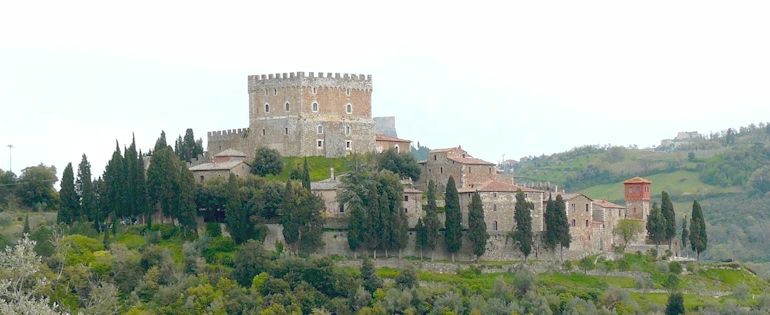|
The
Castle of Ripa D'Orcia, in earlier times, Ripa al Cotone, is
documented as having been sold between 1250 and 1258 by the Consorteria dei Tinniosi, a political association of related aristocratic families, to the Republic of
Sienna, which valued it for its strategic and military importance during their many bitter struggles
with various powerful families. In 1274, the Ripa d’Orcia Castle, and
much other property, was once more owned by the Salimbeni family who had taken over
the Val d’Orcia and ruled it, in effect, as an independent state. The Ripa al Cotone di Valdorcia, though less valued than other property owned by the Consorteria,
assumed such military significance that it appeared in the 1316 List of Property as “Roccham et fortilitiam de Ripa Cotone” owned by Niccolò and Stricca di Giovanni di
Salimbene. The Consorteria consolidated its position in Val d’Orcia after having obtained
the Emperor Charles IV’s recognition of their rule and in 1355 Giovanni d’Agnolino obtained “recognition and confirmation of the fiefs of Ripa with the related territory and districts and with all the rights of jurisdiction transmissible to his legitimate heirs”.
The 1410 the peace agreement between the Republic and the Salimbeni family
conferred Ripa al Cotone on Antonia de’ Salimbene, yet by 1417 it was Niccolò di Cione di Sandro who, through intervention of the Santa Maria della Scala Hospital, sold the fortress and territory of Ripa del Cotone and Bagno Vignoni “with towers, tenants, houses and fulling mill” to the
Siennese for 5,000 gold florins. Subsequently, in 1437, the Hospital Chapter passed a resolution for the sale to Compagno di Bartolomeo della Agazzara whose descendants, in 1484, conveyed the
estate, with “its boundary on one side the Asso and on the other the Orcia, on the other the court of Sancto Quirico and on the other the court of Vignone” to Francesca, widow of Pietro di Bartolomeo Piccolomini.
Thus from 1484 the castle, together with the fortified village and surrounding land, became the property of the Piccolomini
family.
By this time, the invention of artillery had initiated the decline of the
military importance of castles which were thus reduced to strictly productive use.
Typically, only the profitable parts of the castle estates were retained
and everything else was sold or rented. Unusually, this was not the case for the Ripa d’Orcia
castle properties. Though its cultivable land, like much of the Val
d'Orcia, was not easily worked and had been neglected during the long periods of war, the will of Emilio Piccolomini Carli
in 1605 rendered it inalienable and part of the inheritance of the family’s firstborn son.
At the end of the 19 C, Count Pietro Piccolomini Clementini initiated restoration work
under the supervision of the engineer Savino Cresti, and this was
continued by his widow, Countess Marianna. As a result, the Ripa d’Orcia Castle today retains
many of its original features.
Though it had long lost its military significance, the Castello Ripa d’Orcia continued
to be the centre of production and administration for the vast properties belonging to it.
This ended with the agrarian reforms following WW II and the subsequent disappearance of
sharecropping. The estate was partitioned and the village was abandoned.
Since that time, agriculture has resumed on the remaining property and the
restored castle itself now offers tourist accommodation.
|

